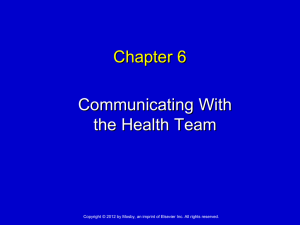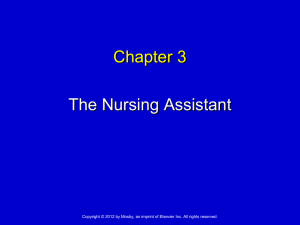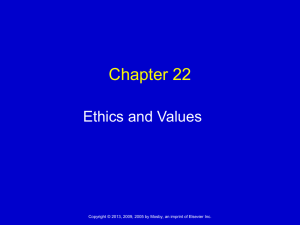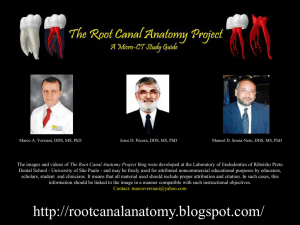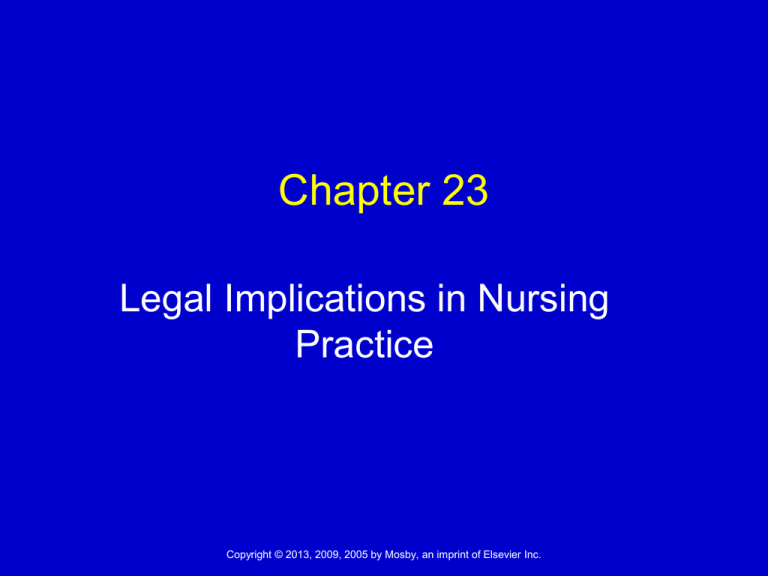
Chapter 23
Legal Implications in Nursing
Practice
Copyright © 2013, 2009, 2005 by Mosby, an imprint of Elsevier Inc.
Legal Limits of Nursing
Sources of legal guidelines come from:
Statutory law (Nurse Practice Act)
• Criminal law (felonies or misdemeanors)
• Civil law
Regulatory law (administrative law)
Common law (judicial decisions)
Copyright © 2013, 2009, 2005 by Mosby, an imprint of Elsevier Inc.
2
Legal Limits of Nursing (cont’d)
Standards of care
Legal guidelines for defining nursing practice and
identifying the minimum acceptable nursing care
Best known comes from the American Nurses
Association (ANA)
Set by every state
Set by state and federal laws that govern where
nurses work
Joint Commission requires policies and
procedures (P&P).
Copyright © 2013, 2009, 2005 by Mosby, an imprint of Elsevier Inc.
3
Case Study
Lynette Donovan, a 15-year-old female African
American, was a passenger in a motor vehicle
collision and is now admitted to the hospital with a
fractured right femur. The emergency department
health care provider applied a cast to the affected leg
with insufficient padding.
Lynnette told the nurses that her right leg felt numb,
was swollen, and looked discolored.
The nurses recognized that these symptoms indicate
impaired circulation in the extremity with the cast.
Copyright © 2013, 2009, 2005 by Mosby, an imprint of Elsevier Inc.
4
Proof of Negligence
The nurse owed a duty to the patient.
The nurse did not carry out the duty or
breached it.
The patient was injured.
The patient’s injury was caused by the
nurse’s failure to carry out that duty.
Copyright © 2013, 2009, 2005 by Mosby, an imprint of Elsevier Inc.
5
Case Study (cont’d)
The nurse was unable to reach Lynette’s
health care provider despite several calls.
The nurse has not notified the nursing
supervisor of the patient’s situation.
David Ortiz is a 23-year-old nursing student
newly assigned to the nursing division and to
Miss Donovan. His initial assessment notes
that the patient’s right leg is swollen, slightly
blue, and slightly malodorous. Lynette seems
very anxious and upset.
Copyright © 2013, 2009, 2005 by Mosby, an imprint of Elsevier Inc.
6
Federal Statutory Issues in Nursing
Practice
Americans With
Disabilities Act
Emergency Medical
Treatment and Active
Labor Act
Mental Health Parity Act Uniform Anatomical Gift
Act
Copyright © 2013, 2009, 2005 by Mosby, an imprint of Elsevier Inc.
7
Federal Statutory Issues in Nursing
Practice (cont’d)
Living Wills, Durable
Power of Attorney
Health Insurance
Portability and
Accountability Act
Advance Directives
Restraints
Copyright © 2013, 2009, 2005 by Mosby, an imprint of Elsevier Inc.
8
State Statutory Issues in Nursing
Practice
Licensure
Good Samaritan Laws
Public Health Laws
Copyright © 2013, 2009, 2005 by Mosby, an imprint of Elsevier Inc.
9
State Statutory Issues in Nursing
Practice (cont’d)
The Uniform Determination of
Death Act
Physician-Assisted Suicide
Copyright © 2013, 2009, 2005 by Mosby, an imprint of Elsevier Inc.
10
Quick Quiz!
1. A nurse is caring for a patient who states, “I
just want to die.” For the nurse to comply with
this request, the nurse should discuss
A. Living wills.
B. Assisted suicide.
C. Passive euthanasia.
D. Advance directives.
Copyright © 2013, 2009, 2005 by Mosby, an imprint of Elsevier Inc.
11
Civil and Common Law Issues in
Nursing Practice
Torts
Intentional
Assault
Battery
False imprisonment
Copyright © 2013, 2009, 2005 by Mosby, an imprint of Elsevier Inc.
12
Civil and Common Law Issues in
Nursing Practice (cont’d)
Quasi-intentional
Invasion of privacy
Malice
Slander
Libel
Unintentional
Negligence
Malpractice
Copyright © 2013, 2009, 2005 by Mosby, an imprint of Elsevier Inc.
13
Common Negligent Acts
Failure to assess and/or monitor, including
making a nursing diagnosis
Failure to monitor in timely fashion
Failure to use proper equipment to monitor the
patient
Failure to document the monitoring
Failure to notify the health care provider of
problems
Failure to follow orders
Failure to follow the six rights of medication
administration
Copyright © 2013, 2009, 2005 by Mosby, an imprint of Elsevier Inc.
14
Common Negligent Acts (cont’d)
Failure to convey discharge instructions
Failure to ensure patient safety, especially for
patients who have a history of falling, are
heavily sedated, have disequilibrium
problems, are frail, are mentally impaired, get
up in the night, and are uncooperative
Failure to follow policies and procedures
Failure to properly delegate and supervise
Copyright © 2013, 2009, 2005 by Mosby, an imprint of Elsevier Inc.
15
Statutory Guidelines for Legal
Consent for Medical Treatment
Adults
A. Any competent individual 18 years of age
or older for himself or herself
B. Any parent for his or her unemancipated
minor
C. Any guardian for his or her ward
D. Any adult for the treatment of his or her
minor brother or sister (if an emergency, and
parents are not present)
E. Any grandparent for a minor grandchild (if
an emergency, and parents are not present)
Copyright © 2013, 2009, 2005 by Mosby, an imprint of Elsevier Inc.
16
Statutory Guidelines for Legal
Consent for Medical Treatment (cont’d)
Minors
A. For his or her child and any child in his or her
legal custody
B. For himself or herself in the following situations:
1. Lawfully married or a parent (emancipated)
2. Pregnancy (excluding abortions)
3. Venereal disease
4. Drug or substance abuse
Copyright © 2013, 2009, 2005 by Mosby, an imprint of Elsevier Inc.
17
Statutory Guidelines for Legal
Consent for Medical Treatment (cont’d)
• Minors (cont’d)
C. Unemancipated minors may not consent to
abortion without one of the following:
1. Consent of one parent
2. Self-consent granted by court order
3. Consent specifically given by a court
Copyright © 2013, 2009, 2005 by Mosby, an imprint of Elsevier Inc.
18
Case Study (cont’d)
David remembers that Lynette Donovan is
legally a minor. She is hurt and afraid and in
an unfamiliar setting.
She may not be comfortable speaking with
the health care providers who are present,
and her expressions of pain may be modified
by the circumstances she is in.
Copyright © 2013, 2009, 2005 by Mosby, an imprint of Elsevier Inc.
19
Abortion Issues
1973 Roe v. Wade
U.S. Supreme Court ruled that there is a
fundamental right to privacy, which includes a
woman’s right to have an abortion.
1989 Webster v. Reproductive Health
Services
Some states require viability tests if the fetus is
more than 28 weeks’ gestational age.
Copyright © 2013, 2009, 2005 by Mosby, an imprint of Elsevier Inc.
20
Nursing Students
You are liable if your actions cause harm to
patients, as is your instructor, hospital, and
college/university.
You are expected to perform as a
professional when rendering care.
You must separate your student nurse role
from your work as a certified nursing assistant
(CNA).
Copyright © 2013, 2009, 2005 by Mosby, an imprint of Elsevier Inc.
21
Malpractice Insurance
A contract between the nurse and the
insurance company
Provides a defense when a nurse is in a
lawsuit involving negligence or malpractice
insurance
Nurses covered by institution’s insurance
while working
Copyright © 2013, 2009, 2005 by Mosby, an imprint of Elsevier Inc.
22
Quick Quiz!
2. A student nurse employed as a nursing
assistant may perform care
A. As learned in school.
B. Expected of a nurse at that level.
C. Identified in the hospital’s job description.
D. Requiring technical rather than professional
skills.
Copyright © 2013, 2009, 2005 by Mosby, an imprint of Elsevier Inc.
23
Abandonment and Assignment
Issues
Short staffing
Floating
Legal problems occur if inadequate number of
nurses will provide care.
Based on census load and patient acuities
Physician’s orders
Nurses follow orders unless they believe an order
is given in error or is harmful.
Copyright © 2013, 2009, 2005 by Mosby, an imprint of Elsevier Inc.
24
Case Study (cont’d)
Lynette Donovan developed gangrene in the
right leg. She requires a right below-the-knee
amputation.
David Ortiz is returning from escorting Miss
Donovan to the operating room for her
procedure. He gets on the elevator, where
several visitors and two nursing supervisors
are talking about the health care provider who
“made Donovan lose her leg.”
Copyright © 2013, 2009, 2005 by Mosby, an imprint of Elsevier Inc.
25
Quick Quiz!
3. You are about to administer an oral
medication and you question the dosage. You
should
A. Administer the medication.
B. Notify the physician.
C. Withhold the medication.
D. Document that the dosage appears incorrect.
Copyright © 2013, 2009, 2005 by Mosby, an imprint of Elsevier Inc.
26
Risk Management
A system of ensuring appropriate nursing
care that attempts to identify potential
hazards and eliminate them before harm
occurs
Steps involved:
Identify possible risks.
Analyze risks.
Act to reduce risks.
Evaluate steps taken.
Copyright © 2013, 2009, 2005 by Mosby, an imprint of Elsevier Inc.
27
Risk Management (cont’d)
One tool used in risk management is the
incident report or occurrence report.
Occurrence reporting
Serves as a database for further investigation
Alerts risk management to a potential claim
situation.
Copyright © 2013, 2009, 2005 by Mosby, an imprint of Elsevier Inc.
28
Chapter 26
Documentation and
Informatics
Copyright © 2013, 2009, 2005 by Mosby, an imprint of Elsevier Inc.
Confidentiality
Nurses are legally and ethically obligated to
keep all patient information confidential.
Nurses are responsible for protecting records
from all unauthorized readers.
HIPAA requires that disclosure or requests
regarding health information are limited to the
minimum necessary.
Copyright © 2013, 2009, 2005 by Mosby, an imprint of Elsevier Inc.
30
Quick Quiz!
1. Information regarding a patient’s health status may
not be released to non–health care team members
because
A. Legal and ethical obligations require health care
providers to keep information strictly confidential.
B. Regulations require health care institutions to
document evidence of physical and emotional wellbeing.
C. Reimbursement issues related to patient care and
procedures may be of concern.
D. Fragmentation of nursing and medical care
procedures may be identified.
Copyright © 2013, 2009, 2005 by Mosby, an imprint of Elsevier Inc.
31
Standards
Current documentation standards require that
each patient have an assessment:
Physical, psychosocial, environmental, self-care,
patient education, knowledge level, and discharge
planning needs
Nursing documentation standards are set by
federal and state regulations, state statutes,
standards of care, and accreditation
agencies.
Copyright © 2013, 2009, 2005 by Mosby, an imprint of Elsevier Inc.
32
Interdisciplinary Communication
Within the Health Care Team
Interdisciplinary communication is essential
within the health care team.
Records or chart
Reports
Confidential permanent legal document
Oral, written, or audiotaped exchange of
information
Conferences
Team members communicating in a group
Copyright © 2013, 2009, 2005 by Mosby, an imprint of Elsevier Inc.
33
Interdisciplinary Communication
Within the Health Care Team (cont’d)
Consultations
A professional caregiver giving formal advice to
another caregiver
Referrals
Arrangement for services by another care provider
Copyright © 2013, 2009, 2005 by Mosby, an imprint of Elsevier Inc.
34
Purposes of Records
Communication
Legal documentation
Reimbursement
Education
Research
Auditing/monitoring
Copyright © 2013, 2009, 2005 by Mosby, an imprint of Elsevier Inc.
35
Legal Guidelines for Recording
•
•
•
•
•
•
•
•
•
Correct all errors promptly, using the correct method.
Record all facts; do not enter personal opinions.
Do not leave blank spaces in nurses’ notes.
Write legibly in permanent blank ink.
If an order was questioned, record that clarification
was sought.
Chart only for yourself, not for others.
Avoid generalizations.
Begin each entry with the date/time and end with
your signature and title.
Keep your computer password secure.
Copyright © 2013, 2009, 2005 by Mosby, an imprint of Elsevier Inc.
36
Guidelines for Quality Documentation
and Reporting
Factual
Accurate
Complete
Current
Organized
Copyright © 2013, 2009, 2005 by Mosby, an imprint of Elsevier Inc.
37
Case Study
Mrs. Smith is a 93-year-old patient with fractures in
her lower spine resulting from severe osteoarthritis
that can be treated with surgery. She reports her
pain as 10 out of 10.
Copyright © 2013, 2009, 2005 by Mosby, an imprint of Elsevier Inc.
38
Case Study (cont’d)
While completing Mrs. Smith's admission
history, you find out that she had a total
knee replacement 3 years ago and pain was
not well controlled at that time.
Mrs. Smith tells you, “I'm dreading surgery.
Last time, I had such pain when I got out of
bed.”
Copyright © 2013, 2009, 2005 by Mosby, an imprint of Elsevier Inc.
39
Quick Quiz!
2. A nurse has just admitted a patient with a
medical diagnosis of congestive heart failure.
When completing the admission paper work,
the nurse needs to record
A. An interpretation of patient behavior.
B. Objective data that are observed.
C. Lengthy entry using lay terminology.
D. Abbreviations familiar to the nurse.
Copyright © 2013, 2009, 2005 by Mosby, an imprint of Elsevier Inc.
40
Methods of Recording
Paper record
Episode-oriented
Key information may be lost from one episode of
care to the next.
Electronic health record (EHR)
A digital version of a patient’s medical record
Integrates all of a patient’s information in one
record
Improves continuity of care
Copyright © 2013, 2009, 2005 by Mosby, an imprint of Elsevier Inc.
41
Methods of Recording (cont’d)
Narrative
The traditional method
Problem-oriented medical record (POMR)
Database
Problem list
Care plan
Progress notes
Copyright © 2013, 2009, 2005 by Mosby, an imprint of Elsevier Inc.
42
Methods of Recording:
Progress Notes
SOAP
SOAPIE
Subjective, objective, assessment, plan,
intervention, evaluation
PIE
Subjective, objective, assessment, plan
Problem, intervention, evaluation
Focus charting (DAR)
Data, action, response
Copyright © 2013, 2009, 2005 by Mosby, an imprint of Elsevier Inc.
43
Methods of Reporting
Source records
Charting by exception (CBE)
A separate section for each discipline
Focuses on documenting deviations
Case management plan and critical pathways
Incorporate a multidisciplinary approach to care
Variances
Copyright © 2013, 2009, 2005 by Mosby, an imprint of Elsevier Inc.
44
Quick Quiz!
3. A nurse records that the patient stated his
abdominal pain is worse now than last night.
This is an example of
A. PIE documentation.
B. SOAP documentation.
C. Narrative charting.
D. Charting by exception.
Copyright © 2013, 2009, 2005 by Mosby, an imprint of Elsevier Inc.
45
Common Record-Keeping Forms
Admission nursing history form
Flow sheets and graphic records
Guides the nurse through a complete assessment
to identify relevant nursing diagnoses or problems
Help team members quickly see patient trends
over time and decrease time spent on writing
narrative notes
Patient care summary or Kardex
A portable “flip-over” file or notebook with patient
information
Copyright © 2013, 2009, 2005 by Mosby, an imprint of Elsevier Inc.
46
Common Record-Keeping Forms
(cont’d)
Standardized care plans
Preprinted, established guidelines used to care for
patients who have similar health problems
Discharge summary forms
Acuity records
Copyright © 2013, 2009, 2005 by Mosby, an imprint of Elsevier Inc.
47
Case Study (cont’d)
Mrs. Smith’s surgery is successful, and she
has been discharged by her physician.
What are some key points to consider in
providing discharge information?
Copyright © 2013, 2009, 2005 by Mosby, an imprint of Elsevier Inc.
48
Home Care Documentation
Medicare has specific guidelines for establishing
eligibility for home care.
Medicare guidelines for establishing a patient’s home
care cost reimbursement serve as the basis for
documentation by home care nurses.
Documentation is the quality control and justification
for reimbursement from Medicare, Medicaid, or
private insurance.
Nurses need to document all their services for
payment.
Copyright © 2013, 2009, 2005 by Mosby, an imprint of Elsevier Inc.
49
Long-Term Health Care
Documentation
Governmental agencies are instrumental in
determining standards and policies for
documentation.
The Omnibus Budget Reconciliation Act of
1987 includes Medicare and Medicaid
legislation for long-term care documentation.
The department of health in states governs
the frequency of written nursing records.
Copyright © 2013, 2009, 2005 by Mosby, an imprint of Elsevier Inc.
50
Reporting
Hand-off report
Occurs with transfer of patient care
Provides continuity and individualized care
Reports are quick and efficient.
Copyright © 2013, 2009, 2005 by Mosby, an imprint of Elsevier Inc.
51
Reporting (cont’d)
Telephone reports and orders
Situation-background-assessmentrecommendation (SBAR)
Document every call
Read back
Incident or occurrence reports
Used to document any event that is not consistent
with the routine operation of a health care unit or
the routine care of a patient
Follow agency policy
Copyright © 2013, 2009, 2005 by Mosby, an imprint of Elsevier Inc.
52
Quick Quiz!
4. A patient you are assisting has fallen in the
shower. You must complete an incident report.
The purpose of an incident report is to
A. Exchange information among health care
members.
B. Provide information about patients from one
unit to another unit.
C. Ensure proper care for the patient.
D. Aid in the hospital’s quality improvement
program.
Copyright © 2013, 2009, 2005 by Mosby, an imprint of Elsevier Inc.
53
Health Informatics
Application of computer and information
science for managing health-related data
Focus on the patient and the process of care
Goal is to enhance the quality and efficiency
of care provided.
Driven by the Health Information Technology
for Economic and Clinical Health Act
(HITECH)
Copyright © 2013, 2009, 2005 by Mosby, an imprint of Elsevier Inc.
54
Nursing Informatics
A specialty that integrates nursing science,
computer science, and information science to
manage and communicate data, information,
and knowledge in nursing practice
Health care information system (HIS): a group
of systems used in a health care organization
to support and enhance health care
Consists of one or more
Computerized clinical information systems (CISs)
Administrative information systems
Copyright © 2013, 2009, 2005 by Mosby, an imprint of Elsevier Inc.
55
Nursing Informatics (cont’d)
A specialty that integrates nursing
science, computer science, and
information science to manage and
communicate data, information, and
knowledge in nursing practice
Supports the way that
nurses function and work
Supports and enhances nursing practice
through improved access to information and
clinical decision-making tools
Copyright © 2013, 2009, 2005 by Mosby, an imprint of Elsevier Inc.
56
Nursing Information Systems
Two designs of
NISs
Nursing process
design
Protocol or critical
pathway design
Clinical decision
support systems
(CDSSs)
Used to support
decision making
Copyright © 2013, 2009, 2005 by Mosby, an imprint of Elsevier Inc.
57
Advantages of NISs
Increased time to spend with patients
Better access to information
Enhanced quality of documentation
Reduced errors of omission
Reduced hospital costs
Increased nurse job satisfaction
Compliance with accrediting agencies
Common clinical database development
Copyright © 2013, 2009, 2005 by Mosby, an imprint of Elsevier Inc.
58
Nursing Information Systems (cont’d)
Privacy, confidentiality, and security mechanisms
Legal risks
Handling and disposal of information
Protection of the confidentiality of patients’ health
information and the security of computer systems are
top priorities that include log-in processes, audit
trails, firewalls, data recovery processes, and policies
about handling and disposing of data to protect
patient information.
Copyright © 2013, 2009, 2005 by Mosby, an imprint of Elsevier Inc.
59
Clinical Information Systems
A hospital information system consists of two major
types of information systems: CISs and
administrative information systems.
CIS = Monitoring systems, order entry, and
laboratory, radiology, and pharmacy systems
Computerized provider order entry (CPOE)
Improves accuracy
Speeds implementation
Improves productivity
Saves money
Copyright © 2013, 2009, 2005 by Mosby, an imprint of Elsevier Inc.
60
Chapter 27
Patient Safety
Copyright © 2013, 2009, 2005 by Mosby, an imprint of Elsevier Inc.
Safety in Health Care Organizations
Performance improvement
Risk management and safety reports
Current reliable technology
Evidence-based practice
Safe work environment
Adequate staff education
Copyright © 2013, 2009, 2005 by Mosby, an imprint of Elsevier Inc.
62
Quality and Safety Education
for Nurses (QSEN)
Future nurses need knowledge, skills, and
attitudes to promote safety.
Continuous improvement is essential.
QSEN minimizes risk of harm to patients and
providers by
System effectiveness
Individual performance
Copyright © 2013, 2009, 2005 by Mosby, an imprint of Elsevier Inc.
63
Critical Thinking
In patient safety, critical thinking is an
ongoing process.
Standards have been developed by American
Nurses Association and The Joint
Commission.
Use of the nursing process when planning
care promotes safety.
Copyright © 2013, 2009, 2005 by Mosby, an imprint of Elsevier Inc.
64
Safety in Health Care Settings
Reduces the incidence of illness and injury
Prevents extended length of treatment/stay
Improves or maintains functional status
Increases patient’s sense of well-being
Copyright © 2013, 2009, 2005 by Mosby, an imprint of Elsevier Inc.
65
A Safe Environment
Includes meeting patients’ physical and
psychosocial needs
Applies to all places where patients receive
care
Includes patients’ and health care providers’
well-being
Reduces risk of injury and transmission of
pathogens
Maintains sanitation and reduces pollution
Copyright © 2013, 2009, 2005 by Mosby, an imprint of Elsevier Inc.
66
Basic Human Needs
Oxygen
Temperature
Low concentration
High concentration
Carbon monoxide
Normal
Hyperthermia
Hypothermia
Nutrition
Proper storage
Proper refrigeration
Preparation area
Copyright © 2013, 2009, 2005 by Mosby, an imprint of Elsevier Inc.
67
Case Study
Mr. Gonzales is a 68-year-old man who has lived
alone in a senior apartment building since his wife
died 6 months ago. He and his wife were born in
Mexico but came to live in the United States shortly
after they were married.
He is retired from a produce warehouse, where he
worked for 37 years. They have raised 3 sons; the
closest son, Carlos, is 30 minutes away by car.
Carlos visits Mr. Gonzales every week to socialize
and take him shopping.
Copyright © 2013, 2009, 2005 by Mosby, an imprint of Elsevier Inc.
68
Environmental Hazards
Physical hazards:
Lighting
Obstacles
Bathroom hazards
Motor vehicle
accidents
Poison
Fires
Copyright © 2013, 2009, 2005 by Mosby, an imprint of Elsevier Inc.
69
Quick Quiz!
1. While caring for a child, you identify that
additional safety teaching is needed when a
young and inexperienced mother states that
A. Teenagers need to practice safe sex.
B. A 3-year-old can safely sit in the front seat of
the car.
C. Children need to wear safety equipment
when bike riding.
D. Children need to learn to swim even if they
do not have a pool.
Copyright © 2013, 2009, 2005 by Mosby, an imprint of Elsevier Inc.
70
Environmental Hazards
Falls
Transmission of pathogens
Pollution
Disasters
Natural
Man-made
Copyright © 2013, 2009, 2005 by Mosby, an imprint of Elsevier Inc.
71
Case Study (cont’d)
Mr. Gonzales is generally healthy but has
decreased visual acuity, hearing loss from the
noisy warehouse job, and some “arthritis.”
He expects to live at least as long as his
father, who lived to be 92 years old. Since his
wife’s death, Mr. Gonzales has attended
Catholic mass every day at his parish church,
where his wife had attended daily.
Copyright © 2013, 2009, 2005 by Mosby, an imprint of Elsevier Inc.
72
Safety Risks by
Developmental Stage
Children younger
than 5 years of
age
School-aged
child
Adolescent
Adult
Older patient
Copyright © 2013, 2009, 2005 by Mosby, an imprint of Elsevier Inc.
73
Nursing Knowledge Base
Factors influencing safety:
Developmental stages
Individual risk factors
• Mobility, sensory, and cognitive status
• Impaired mobility
• Lifestyle choices
• Lack of safety awareness
Risks in the health care agency
Copyright © 2013, 2009, 2005 by Mosby, an imprint of Elsevier Inc.
74
Case Study (cont’d)
Joani Green, a 25-year-old married mother of two, is currently a
nursing student at the local college. As part of the clinical
environment, she and her study partner are conducting health
screenings and providing health promotion education for the
residents of apartments where Mr. Gonzales lives.
Copyright © 2013, 2009, 2005 by Mosby, an imprint of Elsevier Inc.
75
National Quality Forum
List of serious reportable events (SREs)
Surgical events
Product or device events
Patient protection events
Care management events
Environmental events
Criminal events
Procedure to report an event
Copyright © 2013, 2009, 2005 by Mosby, an imprint of Elsevier Inc.
76
CMS list of “Never Events”
“Never events” should never occur.
The Centers for Medicare and Medicaid
Services (CMS) now denies hospitals higher
payments resulting from or complicated by a
“never event.”
Many hospital-acquired conditions are nurse
sensitive indicators.
Copyright © 2013, 2009, 2005 by Mosby, an imprint of Elsevier Inc.
77
Risks in Health Care Agencies
Chemical use (Material Safety Data Sheets
[MSDSs])
Medical errors
Medication errors
Infection
Bed sores
Failure to diagnose and treat in time
Falls
Copyright © 2013, 2009, 2005 by Mosby, an imprint of Elsevier Inc.
78
Risks in Health Care Agency
(cont’d)
Classification of health care agency
accidents:
Patient-inherent accidents
Procedure-related accidents
Equipment-related accidents
Copyright © 2013, 2009, 2005 by Mosby, an imprint of Elsevier Inc.
79
Safety and the Nursing Process
Assessment
Through the patient’s eyes
Patient’s home environment
Assessment questions
• Activity and exercise
• Medication history
• History of falls
• Home maintenance and safety
Nursing history
Copyright © 2013, 2009, 2005 by Mosby, an imprint of Elsevier Inc.
80
Safety and the Nursing Process
(cont’d)
Assessment (cont’d)
Health care environment
• Risks in immediate environment
• Risk for falls
• Risk for medication errors
• Disaster preparedness
Copyright © 2013, 2009, 2005 by Mosby, an imprint of Elsevier Inc.
81
Diagnosis
Nursing diagnoses for patients with safety risk:
Risk for falls
Impaired home maintenance
Risk for injury
Deficient knowledge
Risk for poisoning
Risk for suffocation
Risk for trauma
Copyright © 2013, 2009, 2005 by Mosby, an imprint of Elsevier Inc.
82
Case Study (cont’d)
Joani has also discovered through the
screening that Mr. Gonzales has decreased
visual acuity and has not had a new pair of
glasses for 3 years.
He fell in his apartment about a month ago
but did not have any injuries.
Gait assessment reveals that Mr. Gonzales
does not pick his feet very high up off the
floor, and his movements are stiff.
Copyright © 2013, 2009, 2005 by Mosby, an imprint of Elsevier Inc.
83
Safety and the Nursing Process:
Planning
Goals and outcomes
Prevent and minimize safety threats
Are measurable and realistic
May include active patient participation
Setting priorities
Teamwork and collaboration
Goals for Mr. Gonzales
Copyright © 2013, 2009, 2005 by Mosby, an imprint of Elsevier Inc.
84
Safety and the Nursing Process:
Implementation
Health promotion
Individualization of
implementation
Developmental stage
Lifestyle
Environment
Copyright © 2013, 2009, 2005 by Mosby, an imprint of Elsevier Inc.
85
Safety and the Nursing Process:
Implementation (cont’d)
Basic needs
General preventive
measures
Lighting
Changing the
environment
Copyright © 2013, 2009, 2005 by Mosby, an imprint of Elsevier Inc.
86
Case Study (cont’d)
The son, Carlos, has purchased a medication
organizer that Mr. Gonzales has not used
because he is concerned he will make a
mistake.
Mr. Gonzales is unable to read the labels on
his medication bottles.
What additional interventions are justified as
a result of Mr. Gonzales’ safety assessment?
Copyright © 2013, 2009, 2005 by Mosby, an imprint of Elsevier Inc.
87
Implementation in Acute Care Safety
Fall risk prevention
Restraints as a last
resort
Restraint alternatives
Copyright © 2013, 2009, 2005 by Mosby, an imprint of Elsevier Inc.
88
Safety and the Nursing Process:
Implementation
Acute care safety
Seizures
Poisoning
Electrical hazards
Radiation
Disasters
Hospitals must have an emergency
management plan.
Copyright © 2013, 2009, 2005 by Mosby, an imprint of Elsevier Inc.
89
Implementation
Acute care safety
Fires: “RACE” and “PASS”
• Rescue patients.
• Activate alarm.
• Confine fire.
• Extinguish.
Copyright © 2013, 2009, 2005 by Mosby, an imprint of Elsevier Inc.
90
Implementation (cont’d)
Copyright © 2013, 2009, 2005 by Mosby, an imprint of Elsevier Inc.
91
Quick Quiz!
2. A newly admitted patient was found
wandering the hallways for the past two
nights. The most appropriate nursing
interventions to prevent a fall for this patient
would include
A. Raise all four side rails when darkness falls.
B. Use an electronic bed monitoring device.
C. Place the patient in a room close to the
nursing station.
D. Use a loose-fitting vest-type jacket restraint.
Copyright © 2013, 2009, 2005 by Mosby, an imprint of Elsevier Inc.
92
Case Study (cont’d)
What additional health behavior
can be encouraged for Mr.
Gonzales?
What effects could this health
behavior produce?
Copyright © 2013, 2009, 2005 by Mosby, an imprint of Elsevier Inc.
93
Safety and the Nursing Process:
Evaluation
Through the patient’s eyes
Are the patient’s expectations met?
Are the family’s expectations met?
Patient outcomes
Monitor care by the health care team.
Measure outcomes for each diagnosis.
Continually assess needs for additional support.
Copyright © 2013, 2009, 2005 by Mosby, an imprint of Elsevier Inc.
94
Case Study (cont’d)
It has been 2 weeks since Joani implemented
the plan of care for Mr. Gonzales.
Joani will observe Mr. Gonzales’ environment
for elimination of threats to patient safety.
She will reassess motor, sensory, and
cognitive status for appropriate environmental
modifications.
Copyright © 2013, 2009, 2005 by Mosby, an imprint of Elsevier Inc.
95
Quick Quiz!
3. A nurse floats to a busy surgical unit and
administers a wrong medication to a patient.
This error can be classified as
A. A poisoning accident.
B. An equipment-related accident.
C. A procedure-related accident.
D. An accident related to time management.
Copyright © 2013, 2009, 2005 by Mosby, an imprint of Elsevier Inc.
96
Case Study (cont’d)
With regular exercise, Mr. Gonzales has found that
his walking has improved, and now he feels safer
about leaving the apartment.
The new medication labels and organizer have made
it easier for him to tell his several medications apart.
He reports that his vision is much better with his new
glasses.
He understands that he is able to make changes in
his environment that will keep him safe.
Mr. Gonzales has been injury free and plans to live to
a “ripe old age.”
Copyright © 2013, 2009, 2005 by Mosby, an imprint of Elsevier Inc.
97
Expected Outcomes
A safe physical environment
A patient whose expectations have been met
A patient who is knowledgeable about safety
factors and precautions
A patient free of injury
Copyright © 2013, 2009, 2005 by Mosby, an imprint of Elsevier Inc.
98

